value of money Assignment PDF
VerifiedAdded on 2021/11/23
|8
|1604
|126
AI Summary
Contribute Materials
Your contribution can guide someone’s learning journey. Share your
documents today.

Secure Best Marks with AI Grader
Need help grading? Try our AI Grader for instant feedback on your assignments.
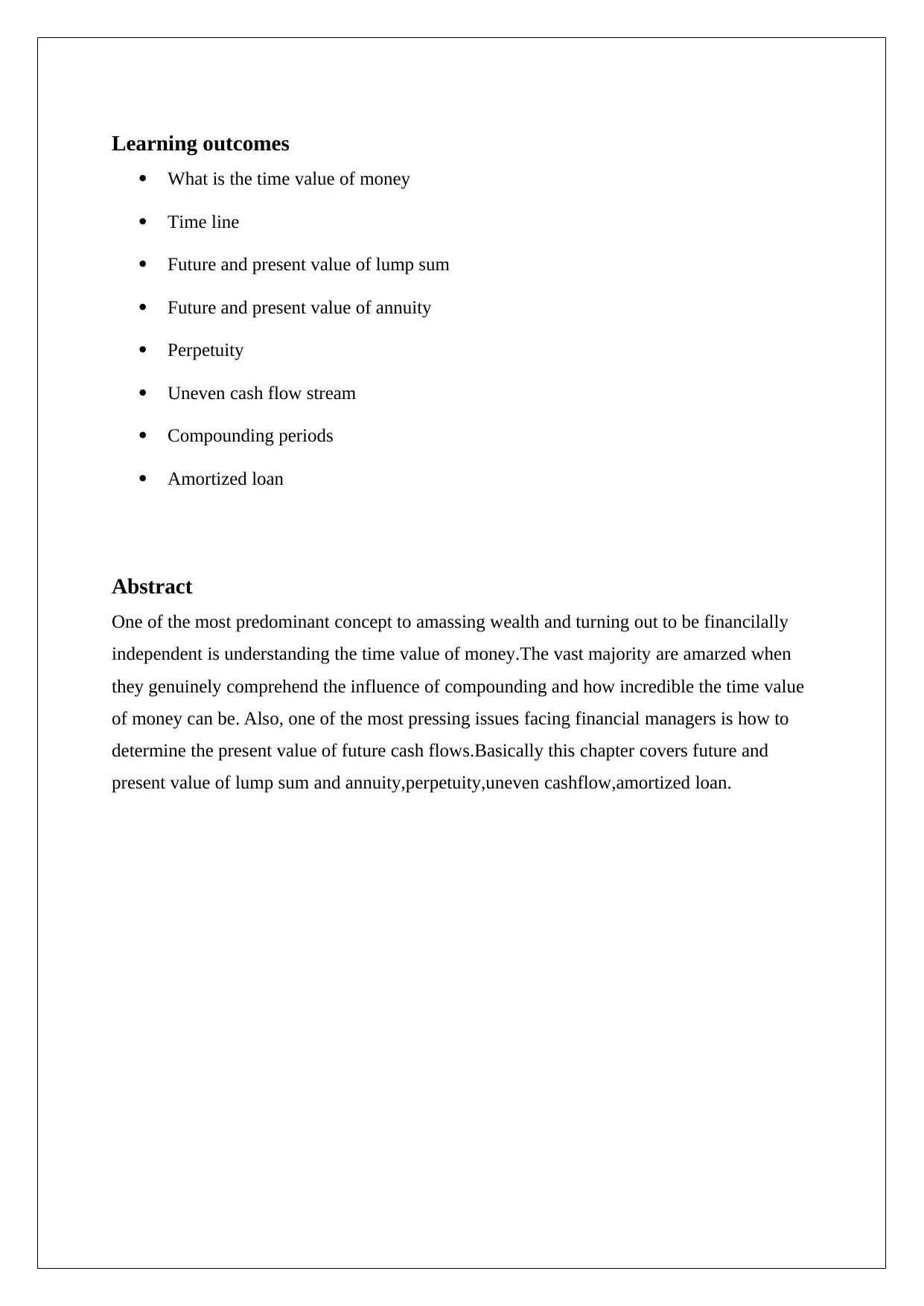
Learning outcomes
What is the time value of money
Time line
Future and present value of lump sum
Future and present value of annuity
Perpetuity
Uneven cash flow stream
Compounding periods
Amortized loan
Abstract
One of the most predominant concept to amassing wealth and turning out to be financilally
independent is understanding the time value of money.The vast majority are amarzed when
they genuinely comprehend the influence of compounding and how incredible the time value
of money can be. Also, one of the most pressing issues facing financial managers is how to
determine the present value of future cash flows.Basically this chapter covers future and
present value of lump sum and annuity,perpetuity,uneven cashflow,amortized loan.
What is the time value of money
Time line
Future and present value of lump sum
Future and present value of annuity
Perpetuity
Uneven cash flow stream
Compounding periods
Amortized loan
Abstract
One of the most predominant concept to amassing wealth and turning out to be financilally
independent is understanding the time value of money.The vast majority are amarzed when
they genuinely comprehend the influence of compounding and how incredible the time value
of money can be. Also, one of the most pressing issues facing financial managers is how to
determine the present value of future cash flows.Basically this chapter covers future and
present value of lump sum and annuity,perpetuity,uneven cashflow,amortized loan.
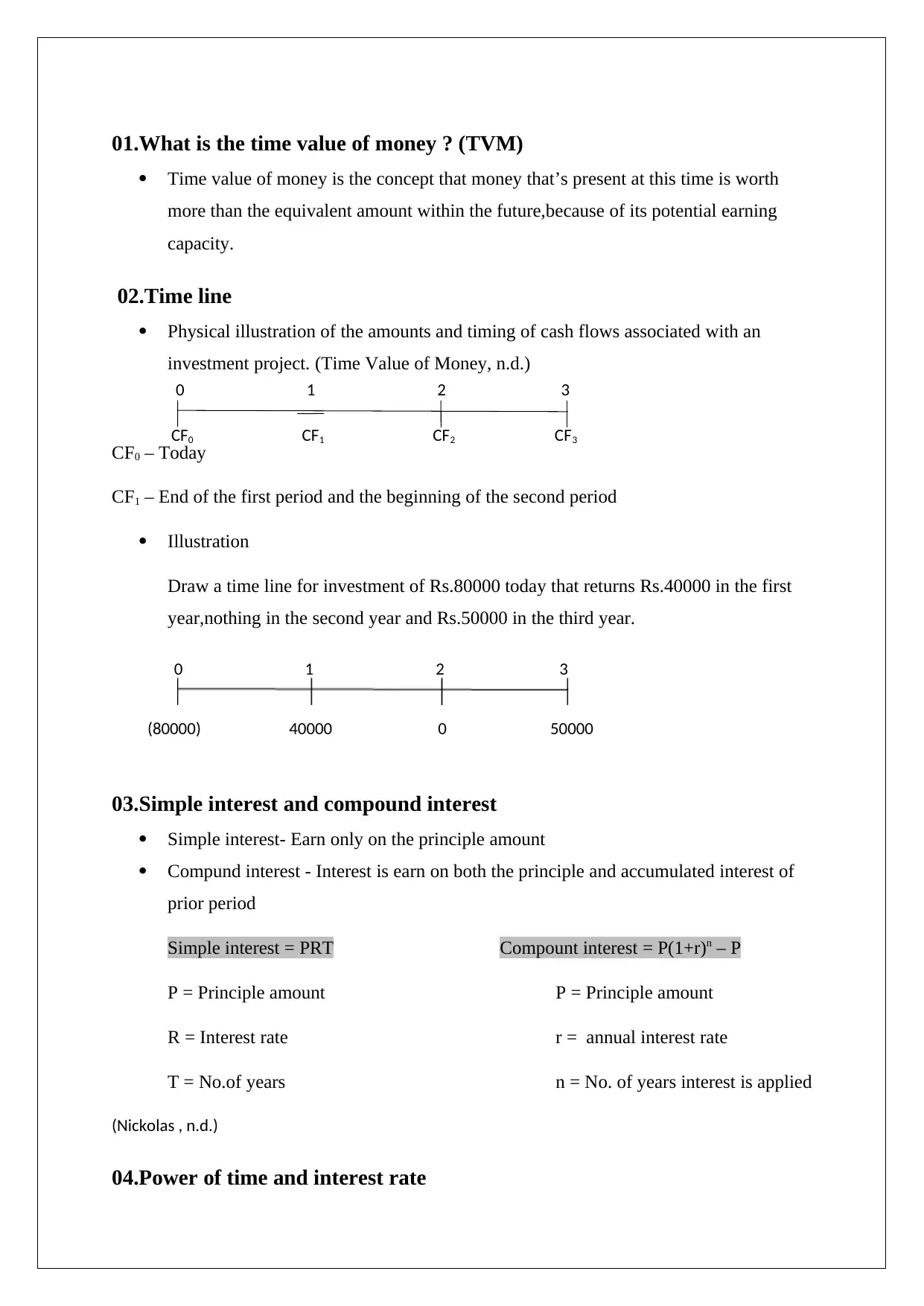
01.What is the time value of money ? (TVM)
Time value of money is the concept that money that’s present at this time is worth
more than the equivalent amount within the future,because of its potential earning
capacity.
02.Time line
Physical illustration of the amounts and timing of cash flows associated with an
investment project. (Time Value of Money, n.d.)
CF0 – Today
CF1 – End of the first period and the beginning of the second period
Illustration
Draw a time line for investment of Rs.80000 today that returns Rs.40000 in the first
year,nothing in the second year and Rs.50000 in the third year.
03.Simple interest and compound interest
Simple interest- Earn only on the principle amount
Compund interest - Interest is earn on both the principle and accumulated interest of
prior period
Simple interest = PRT
P = Principle amount
R = Interest rate
T = No.of years
(Nickolas , n.d.)
04.Power of time and interest rate
0 1 2 3
CF0 CF1 CF2 CF3
0 1 2 3
(80000) 40000 0 50000
Compount interest = P(1+r)n – P
P = Principle amount
r = annual interest rate
n = No. of years interest is applied
Time value of money is the concept that money that’s present at this time is worth
more than the equivalent amount within the future,because of its potential earning
capacity.
02.Time line
Physical illustration of the amounts and timing of cash flows associated with an
investment project. (Time Value of Money, n.d.)
CF0 – Today
CF1 – End of the first period and the beginning of the second period
Illustration
Draw a time line for investment of Rs.80000 today that returns Rs.40000 in the first
year,nothing in the second year and Rs.50000 in the third year.
03.Simple interest and compound interest
Simple interest- Earn only on the principle amount
Compund interest - Interest is earn on both the principle and accumulated interest of
prior period
Simple interest = PRT
P = Principle amount
R = Interest rate
T = No.of years
(Nickolas , n.d.)
04.Power of time and interest rate
0 1 2 3
CF0 CF1 CF2 CF3
0 1 2 3
(80000) 40000 0 50000
Compount interest = P(1+r)n – P
P = Principle amount
r = annual interest rate
n = No. of years interest is applied
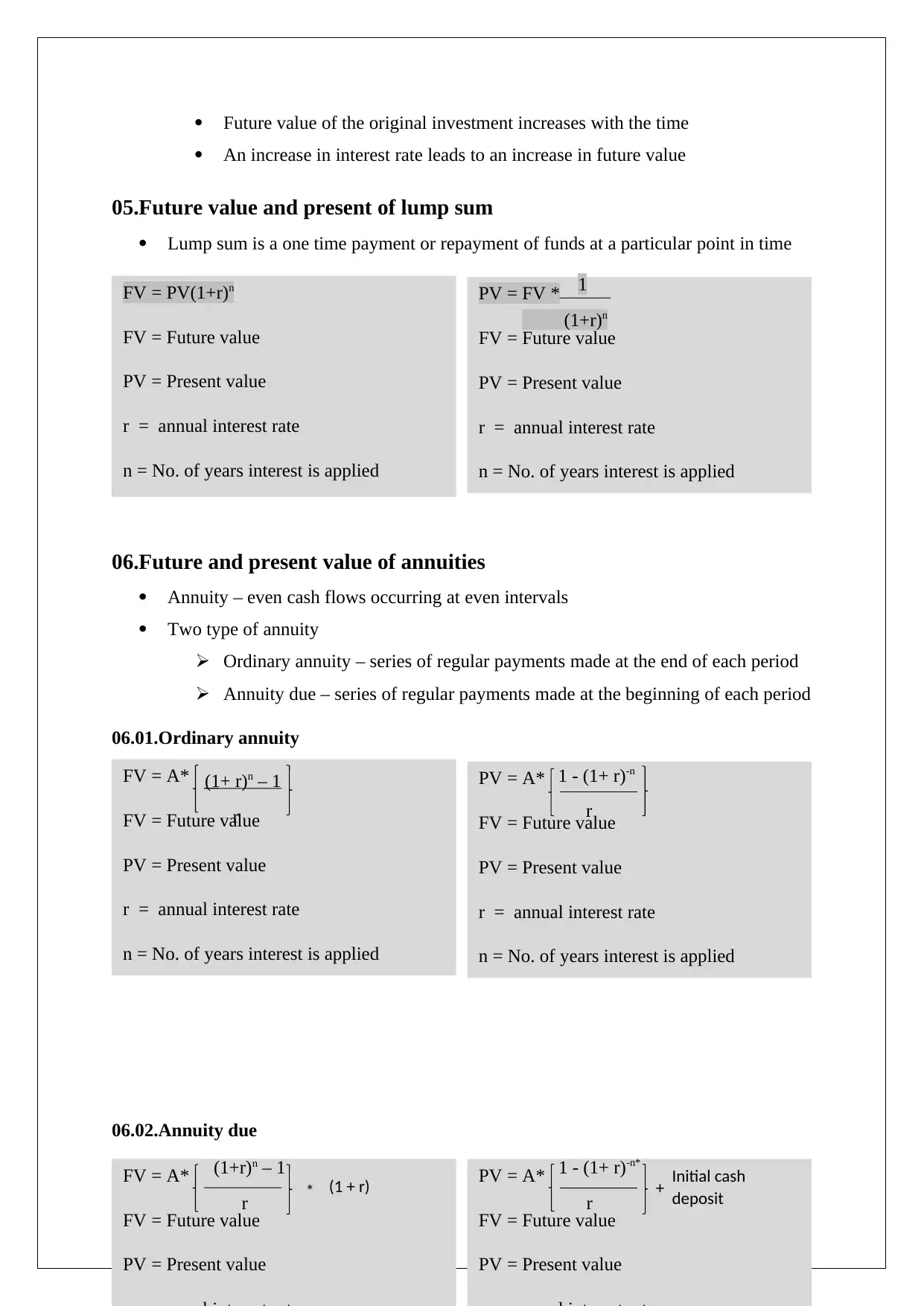
Future value of the original investment increases with the time
An increase in interest rate leads to an increase in future value
05.Future value and present of lump sum
Lump sum is a one time payment or repayment of funds at a particular point in time
06.Future and present value of annuities
Annuity – even cash flows occurring at even intervals
Two type of annuity
Ordinary annuity – series of regular payments made at the end of each period
Annuity due – series of regular payments made at the beginning of each period
06.01.Ordinary annuity
06.02.Annuity due
FV = PV(1+r)n
FV = Future value
PV = Present value
r = annual interest rate
n = No. of years interest is applied
PV = FV *
FV = Future value
PV = Present value
r = annual interest rate
n = No. of years interest is applied
1
(1+r)n
FV = A*
FV = Future value
PV = Present value
r = annual interest rate
n = No. of years interest is applied
(1+ r)n – 1
r
PV = A*
FV = Future value
PV = Present value
r = annual interest rate
n = No. of years interest is applied
1 - (1+ r)-n
r
FV = A*
FV = Future value
PV = Present value
(1+r)n – 1
r (1 + r)* PV = A*
FV = Future value
PV = Present value
1 - (1+ r)-n*
r + Initial cash
deposit
An increase in interest rate leads to an increase in future value
05.Future value and present of lump sum
Lump sum is a one time payment or repayment of funds at a particular point in time
06.Future and present value of annuities
Annuity – even cash flows occurring at even intervals
Two type of annuity
Ordinary annuity – series of regular payments made at the end of each period
Annuity due – series of regular payments made at the beginning of each period
06.01.Ordinary annuity
06.02.Annuity due
FV = PV(1+r)n
FV = Future value
PV = Present value
r = annual interest rate
n = No. of years interest is applied
PV = FV *
FV = Future value
PV = Present value
r = annual interest rate
n = No. of years interest is applied
1
(1+r)n
FV = A*
FV = Future value
PV = Present value
r = annual interest rate
n = No. of years interest is applied
(1+ r)n – 1
r
PV = A*
FV = Future value
PV = Present value
r = annual interest rate
n = No. of years interest is applied
1 - (1+ r)-n
r
FV = A*
FV = Future value
PV = Present value
(1+r)n – 1
r (1 + r)* PV = A*
FV = Future value
PV = Present value
1 - (1+ r)-n*
r + Initial cash
deposit
Secure Best Marks with AI Grader
Need help grading? Try our AI Grader for instant feedback on your assignments.
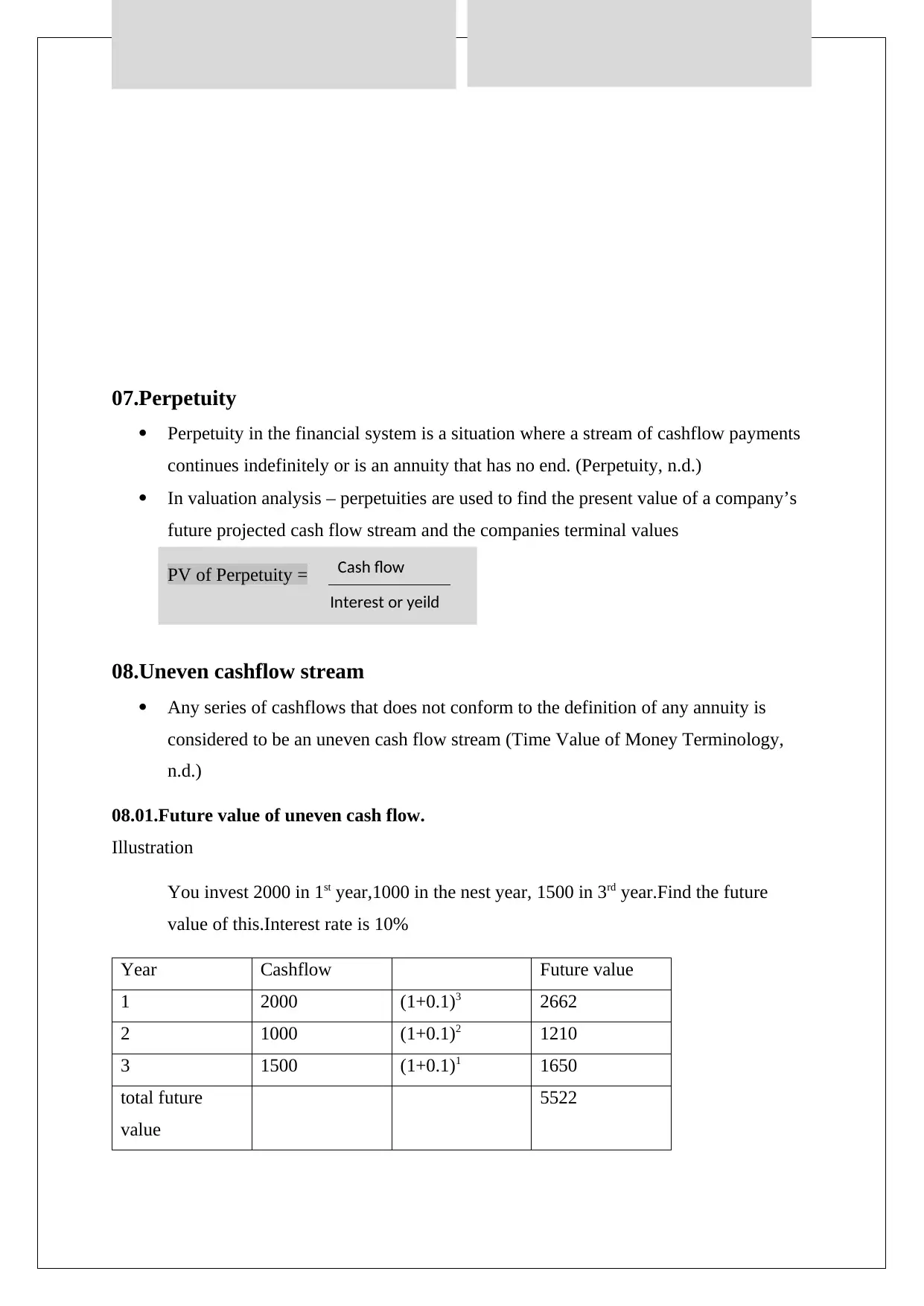
07.Perpetuity
Perpetuity in the financial system is a situation where a stream of cashflow payments
continues indefinitely or is an annuity that has no end. (Perpetuity, n.d.)
In valuation analysis – perpetuities are used to find the present value of a company’s
future projected cash flow stream and the companies terminal values
PV of Perpetuity =
08.Uneven cashflow stream
Any series of cashflows that does not conform to the definition of any annuity is
considered to be an uneven cash flow stream (Time Value of Money Terminology,
n.d.)
08.01.Future value of uneven cash flow.
Illustration
You invest 2000 in 1st year,1000 in the nest year, 1500 in 3rd year.Find the future
value of this.Interest rate is 10%
Year Cashflow Future value
1 2000 (1+0.1)3 2662
2 1000 (1+0.1)2 1210
3 1500 (1+0.1)1 1650
total future
value
5522
Cash flow
Interest or yeild
Perpetuity in the financial system is a situation where a stream of cashflow payments
continues indefinitely or is an annuity that has no end. (Perpetuity, n.d.)
In valuation analysis – perpetuities are used to find the present value of a company’s
future projected cash flow stream and the companies terminal values
PV of Perpetuity =
08.Uneven cashflow stream
Any series of cashflows that does not conform to the definition of any annuity is
considered to be an uneven cash flow stream (Time Value of Money Terminology,
n.d.)
08.01.Future value of uneven cash flow.
Illustration
You invest 2000 in 1st year,1000 in the nest year, 1500 in 3rd year.Find the future
value of this.Interest rate is 10%
Year Cashflow Future value
1 2000 (1+0.1)3 2662
2 1000 (1+0.1)2 1210
3 1500 (1+0.1)1 1650
total future
value
5522
Cash flow
Interest or yeild
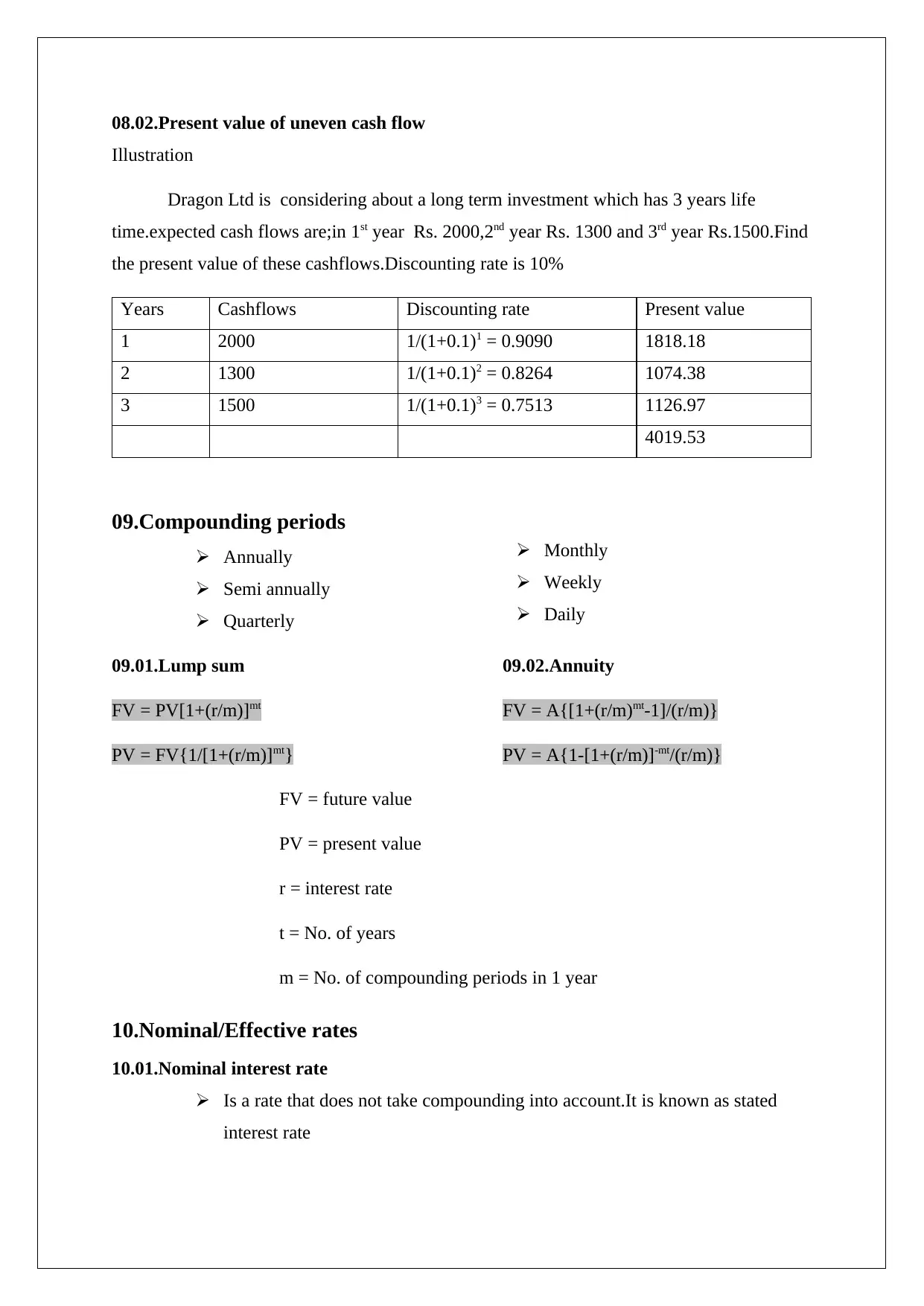
08.02.Present value of uneven cash flow
Illustration
Dragon Ltd is considering about a long term investment which has 3 years life
time.expected cash flows are;in 1st year Rs. 2000,2nd year Rs. 1300 and 3rd year Rs.1500.Find
the present value of these cashflows.Discounting rate is 10%
Years Cashflows Discounting rate Present value
1 2000 1/(1+0.1)1 = 0.9090 1818.18
2 1300 1/(1+0.1)2 = 0.8264 1074.38
3 1500 1/(1+0.1)3 = 0.7513 1126.97
4019.53
09.Compounding periods
Annually
Semi annually
Quarterly
09.01.Lump sum 09.02.Annuity
FV = PV[1+(r/m)]mt FV = A{[1+(r/m)mt-1]/(r/m)}
PV = FV{1/[1+(r/m)]mt} PV = A{1-[1+(r/m)]-mt/(r/m)}
FV = future value
PV = present value
r = interest rate
t = No. of years
m = No. of compounding periods in 1 year
10.Nominal/Effective rates
10.01.Nominal interest rate
Is a rate that does not take compounding into account.It is known as stated
interest rate
Monthly
Weekly
Daily
Illustration
Dragon Ltd is considering about a long term investment which has 3 years life
time.expected cash flows are;in 1st year Rs. 2000,2nd year Rs. 1300 and 3rd year Rs.1500.Find
the present value of these cashflows.Discounting rate is 10%
Years Cashflows Discounting rate Present value
1 2000 1/(1+0.1)1 = 0.9090 1818.18
2 1300 1/(1+0.1)2 = 0.8264 1074.38
3 1500 1/(1+0.1)3 = 0.7513 1126.97
4019.53
09.Compounding periods
Annually
Semi annually
Quarterly
09.01.Lump sum 09.02.Annuity
FV = PV[1+(r/m)]mt FV = A{[1+(r/m)mt-1]/(r/m)}
PV = FV{1/[1+(r/m)]mt} PV = A{1-[1+(r/m)]-mt/(r/m)}
FV = future value
PV = present value
r = interest rate
t = No. of years
m = No. of compounding periods in 1 year
10.Nominal/Effective rates
10.01.Nominal interest rate
Is a rate that does not take compounding into account.It is known as stated
interest rate
Monthly
Weekly
Daily
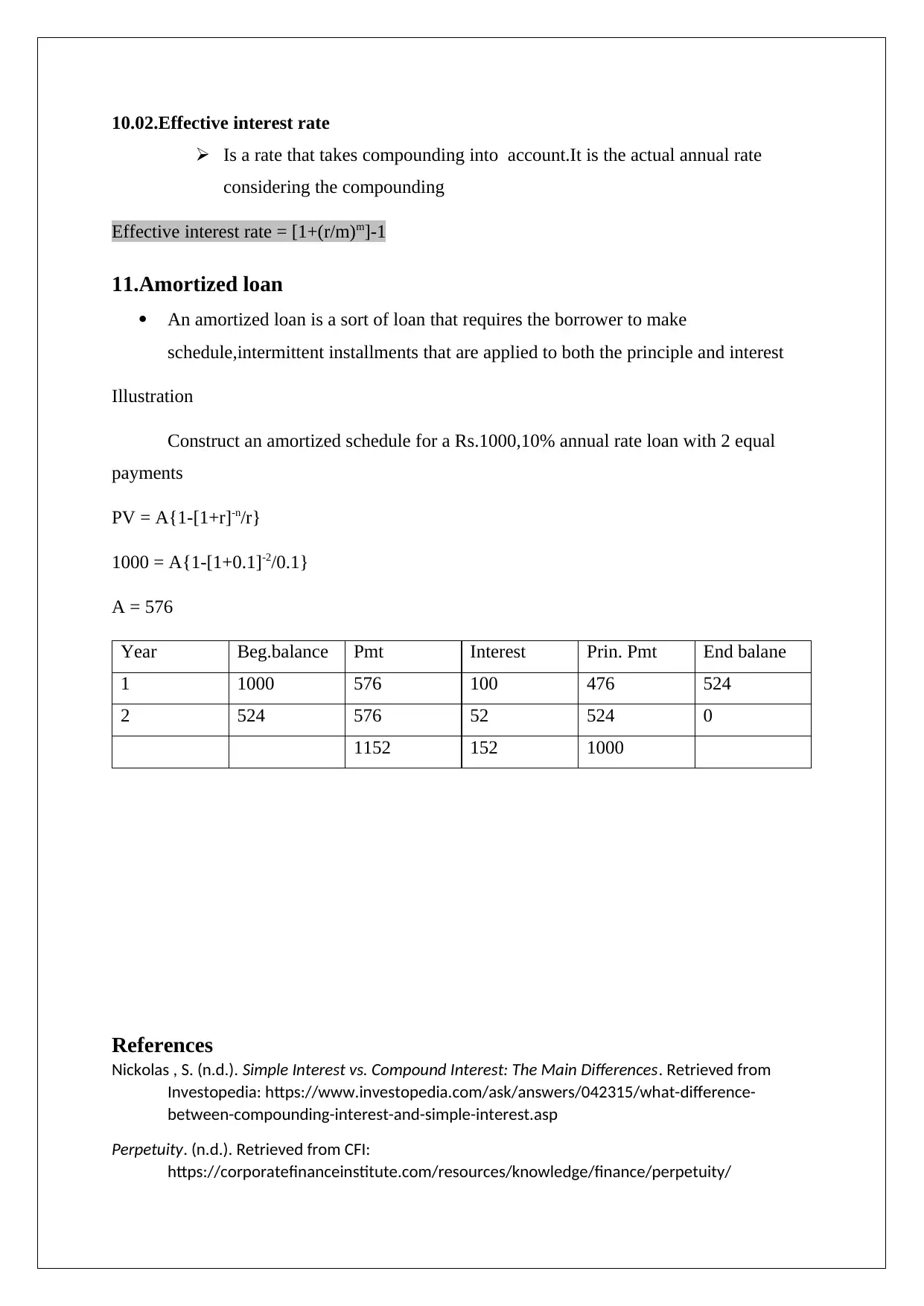
10.02.Effective interest rate
Is a rate that takes compounding into account.It is the actual annual rate
considering the compounding
Effective interest rate = [1+(r/m)m]-1
11.Amortized loan
An amortized loan is a sort of loan that requires the borrower to make
schedule,intermittent installments that are applied to both the principle and interest
Illustration
Construct an amortized schedule for a Rs.1000,10% annual rate loan with 2 equal
payments
PV = A{1-[1+r]-n/r}
1000 = A{1-[1+0.1]-2/0.1}
A = 576
Year Beg.balance Pmt Interest Prin. Pmt End balane
1 1000 576 100 476 524
2 524 576 52 524 0
1152 152 1000
References
Nickolas , S. (n.d.). Simple Interest vs. Compound Interest: The Main Differences. Retrieved from
Investopedia: https://www.investopedia.com/ask/answers/042315/what-difference-
between-compounding-interest-and-simple-interest.asp
Perpetuity. (n.d.). Retrieved from CFI:
https://corporatefinanceinstitute.com/resources/knowledge/finance/perpetuity/
Is a rate that takes compounding into account.It is the actual annual rate
considering the compounding
Effective interest rate = [1+(r/m)m]-1
11.Amortized loan
An amortized loan is a sort of loan that requires the borrower to make
schedule,intermittent installments that are applied to both the principle and interest
Illustration
Construct an amortized schedule for a Rs.1000,10% annual rate loan with 2 equal
payments
PV = A{1-[1+r]-n/r}
1000 = A{1-[1+0.1]-2/0.1}
A = 576
Year Beg.balance Pmt Interest Prin. Pmt End balane
1 1000 576 100 476 524
2 524 576 52 524 0
1152 152 1000
References
Nickolas , S. (n.d.). Simple Interest vs. Compound Interest: The Main Differences. Retrieved from
Investopedia: https://www.investopedia.com/ask/answers/042315/what-difference-
between-compounding-interest-and-simple-interest.asp
Perpetuity. (n.d.). Retrieved from CFI:
https://corporatefinanceinstitute.com/resources/knowledge/finance/perpetuity/
Paraphrase This Document
Need a fresh take? Get an instant paraphrase of this document with our AI Paraphraser
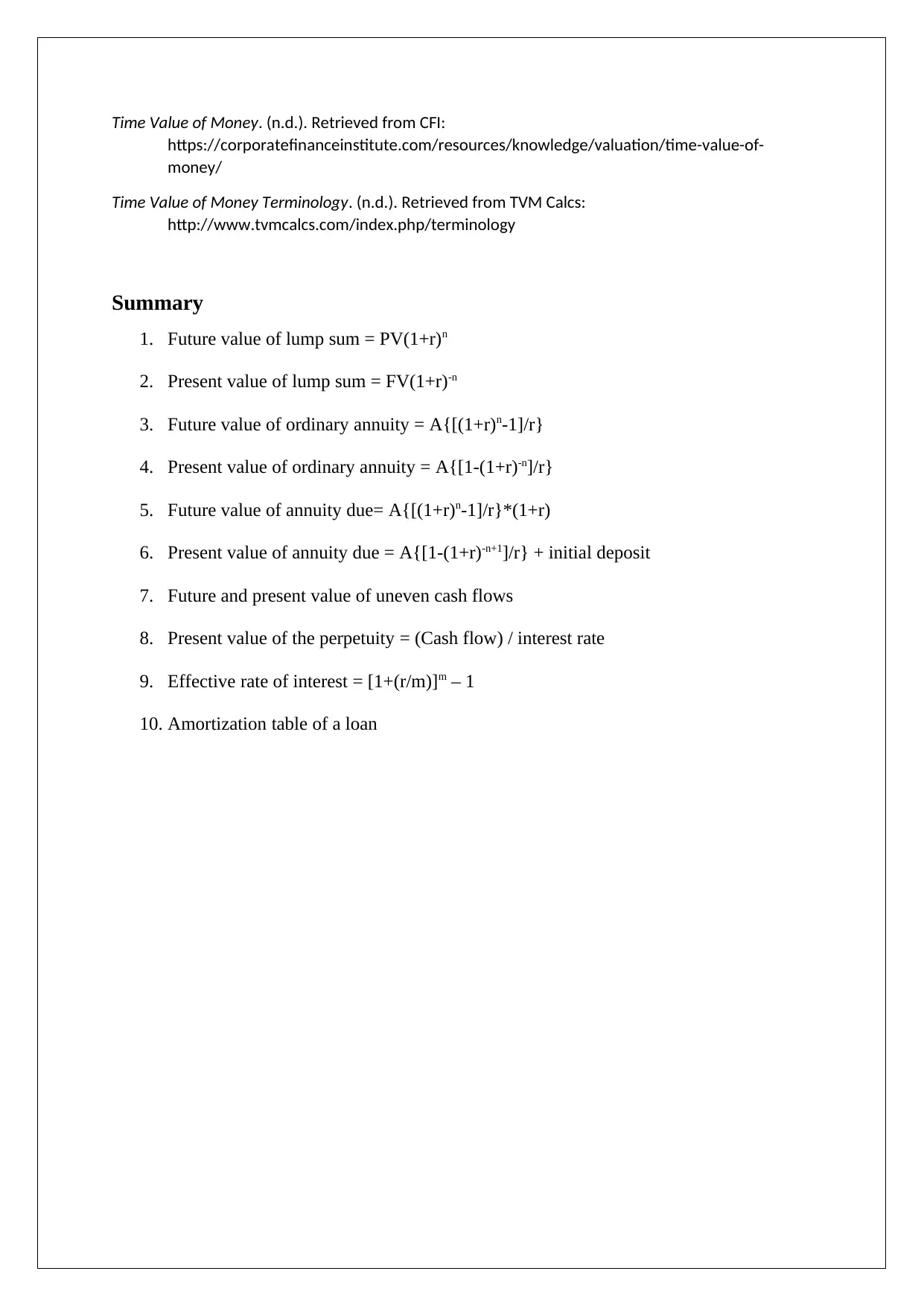
Time Value of Money. (n.d.). Retrieved from CFI:
https://corporatefinanceinstitute.com/resources/knowledge/valuation/time-value-of-
money/
Time Value of Money Terminology. (n.d.). Retrieved from TVM Calcs:
http://www.tvmcalcs.com/index.php/terminology
Summary
1. Future value of lump sum = PV(1+r)n
2. Present value of lump sum = FV(1+r)-n
3. Future value of ordinary annuity = A{[(1+r)n-1]/r}
4. Present value of ordinary annuity = A{[1-(1+r)-n]/r}
5. Future value of annuity due= A{[(1+r)n-1]/r}*(1+r)
6. Present value of annuity due = A{[1-(1+r)-n+1]/r} + initial deposit
7. Future and present value of uneven cash flows
8. Present value of the perpetuity = (Cash flow) / interest rate
9. Effective rate of interest = [1+(r/m)]m – 1
10. Amortization table of a loan
https://corporatefinanceinstitute.com/resources/knowledge/valuation/time-value-of-
money/
Time Value of Money Terminology. (n.d.). Retrieved from TVM Calcs:
http://www.tvmcalcs.com/index.php/terminology
Summary
1. Future value of lump sum = PV(1+r)n
2. Present value of lump sum = FV(1+r)-n
3. Future value of ordinary annuity = A{[(1+r)n-1]/r}
4. Present value of ordinary annuity = A{[1-(1+r)-n]/r}
5. Future value of annuity due= A{[(1+r)n-1]/r}*(1+r)
6. Present value of annuity due = A{[1-(1+r)-n+1]/r} + initial deposit
7. Future and present value of uneven cash flows
8. Present value of the perpetuity = (Cash flow) / interest rate
9. Effective rate of interest = [1+(r/m)]m – 1
10. Amortization table of a loan
1 out of 8
Related Documents
Your All-in-One AI-Powered Toolkit for Academic Success.
+13062052269
info@desklib.com
Available 24*7 on WhatsApp / Email
![[object Object]](/_next/static/media/star-bottom.7253800d.svg)
Unlock your academic potential
© 2024 | Zucol Services PVT LTD | All rights reserved.





